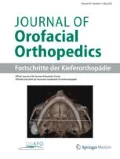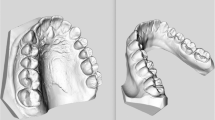Abstract
Objectives
The purpose of this work was to develop cephalometric standards of the vertical dimension of occlusion (VDO) in Moroccan adults.
Methods
Our data consisted of standardized lateral cephalometric radiographs of 98 students at the Casablanca Faculty of Dentistry. These included 74 women and 24 men aged 18–34 years, who were selected on the basis of a well-proportioned face, acceptable profile, Class I occlusion, minor or no crowding, and no history of orthodontic treatment. Mean values of seven (six angle and one linear) dentoskeletal parameters were determined from lateral cephalometric radiographs.
Results
These Moroccans tended to exhibit an opening in the VDO in comparison with the standards of Steiner and Wylie and those of other populations: GoGn/SN: 35.4° ± 5.3°, FMA: 25.6° ± 5.1°, Occ/SN: 19.3° ± 4.7°, Occ/Fr: 9.1° ± 4°, SGn/Fr: 59.2° ± 3.4°, ENA-Xi-Pm: 46.2° ± 4.4°, ENA-Me: 69.7 ± 5.9 mm.
Conclusion
Moroccans have distinct cephalometric characteristics, which should be used as the reference in future orthodontic and prosthetic treatments.
Zusammenfassung
Ziele
Ziel der Arbeit war es, an marokkanischen Erwachsenen kephalometrische Standards für die vertikale Dimension der Okklusion (“vertical dimension of occlusion”, VDO) zu entwickeln.
Methoden
Unsere Daten bestanden aus standardisierten Fernröntgenseitbildern (FRS) von 98 Studierenden der zahnmedizinischen Fakultät an der Universität Casablanca, Marokko. Die Probanden, 74 Frauen und 24 Männer im Alter von 18–34 Jahren, wurden nach folgenden Kriterien ausgewählt: gut proportioniertes Gesicht, akzeptables Profil, Klasse-I-Okklusion, kein bzw. kaum Engstand und keine frühere kieferorthopädische Behandlung. Für 7 dentoskelettale Parameter (6 Winkel, eine Distanz) wurden anhand der FRS Durchschnittswerte ermittelt.
Ergebnisse
Bei den im Rahmen der Studie untersuchten Marokkanern bestand im Vergleich zu sowohl den von Steiner und Wylie entwickelten Standards als auch zu denen anderer Populationen eine Tendenz zu einer Öffnung in der VDO: GoGn/SN: 35,4 ± 5,3°, FMA: 25,6 ± 5,1°, Occ/SN: 19,3 ± 4,7°, Occ/Fr: 9,1 ± 4°, SGn/Fr: 59,2 ± 3,4°, ENA-Xi-Pm: 46,2 ± 4,4°, ENA-Me: 69,7 ± 5,9 mm.
Schlussfolgerung
Bei Marokkanern bestehen ausgeprägte kephalometrische Charakteristika, die künftig als Referenzwerte bei der Planung kieferorthopädischer und prothetischer Behandlungen verwendet werden sollten.

Similar content being viewed by others
References
Ajayi EO (2005) Cephalometric norms of Nigerian children. Am J Orthod Dentofacial Orthop 128(5):653–656
Batarec E (1972) Lexicon of the terms of dental prosthesis. Julien Prelate, Paris
Davoody PR, Sassouni V (1978) Dentofacial pattern differences between Iranians and American Caucasians. Am J Orthod 73(6):667–675
Dawson EP (1989) Evaluation, diagnosis and treatment of occlusal problems. CV Mosby, St Louis, pp 55–69
Fayz F, Eslami A (1988) Determination of vertical occlusal dimension: a literature review. J Prosthet Dent 59(3):321–323 (Review)
Garcia CJ (1975) Cephalometric evaluation of Mexican Americans using the Downs and Steiner analyses. Am J Orthod 68(1):67–74
Gaspard MR (1985) Troubles of dental occlusion and Sadam. In: Procodif-editor Collection of the Dental surgeon
Lahlou K, Bahoum A, Makhoukhi MB, el Aalloula H (2010) Comparison of dentoalveolar protrusion values in Moroccans and other populations. Eur J Orthod 32(4):430–434
Orthlieb JD, Laurent M, Laplanche O (2000) Cephalometric estimation of vertical dimension of occlusion. J Oral Rehabil 27(9):802–807
Orthlieb JD, Rebibo M, Mantout B (2002) The vertical dimension of occlusion in fixed prosthesis: decision criteria. Cah Prothèse 120:67–79
Rivera-Morales WC, Mohl ND (1991) Relationship of occlusal vertical dimension to the health of the masticatory system. J Prosthet Dent 65(4):547–553 Review
Rugh JD, Drago CJ (1981) Vertical dimension: study off clinical rest position and jaw muscle activity. J Prosthet Dent 45(6):670–675
Scheideman GB, Bell WH, Legan HL, Finn RA, Reisch JS (1980) Cephalometric analysis of dentofacial normals. Am J Orthod 78(4):404–420
Sharma JN (2011) Steiner’ S cephalometric norms for the Nepalese population. J Orthod 38(1):21–31
Turrell AJ (1972) Clinical assessment of vertical dimension. J Prosthet Dent 28(3):238–246 (Review)
Woda A, Pionchon P, Palla S (2001) Regulation of mandibular postures: mechanisms and clinical implications. Crit Rev Oral Biol Med 12(2):166–178 (Review)
Author information
Authors and Affiliations
Corresponding author
Ethics declarations
Conflict of interest
Lahcen Ousehal, ElMehdi Jouhadi, and Anas Bennani state that there are no conflicts of interest.
All studies on humans described in the present manuscript were carried out with the approval of the responsible ethics committee and in accordance with national law and the Helsinki Declaration of 1975 (in its current, revised form). Informed consent was obtained from all patients included in studies.
Rights and permissions
About this article
Cite this article
Ousehal, L., Jouhadi, E. & Bennani, A. Vertical dimension of occlusion (VDO): cephalometric norms for a Moroccan population. J Orofac Orthop 77, 39–44 (2016). https://doi.org/10.1007/s00056-015-0006-0
Received:
Accepted:
Published:
Issue Date:
DOI: https://doi.org/10.1007/s00056-015-0006-0




